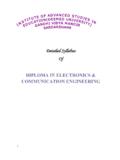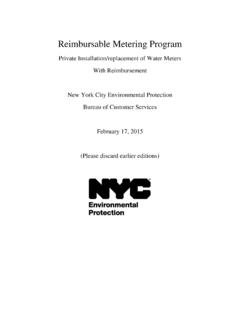Transcription of Detailed Syllabus Of - ::IASE Deemed University::
1 Detailed Syllabus Of DIPLOMA IN MECHANICAL ENGINEERING. 1. COURSE PERIOD: 3 YEARS (SIX SEMESTER) TOTAL MARKS 3000 FIRST SEMESTER COURSE TITLE PAPER MARKS CODE THEORY PRACTICAL TOTAL APPLIED MATHEMATICS I DME 110 100 00 100 APPLIED PHYSICS DME 120 50 50 100 DME 120P APPLIED CHEMISTRY DME 130 50 50 100 DME 130P INTRODUCTION TO IT DME 140 100 00 100 SECOND SEMESTER COURSE TITLE PAPER MARKS CODE THEORY PRACTICAL TOTAL COMMUNICATION SKILLS I DME 210 50 50 100 DME 210P APPLIED MATHEMATICS II DME 220 100 00 100 APPLIED PHYSICS DME 230 50 50 100 DME 230P ENGINEERING DRAWING DME 240 50 50 100 DME 240P WORKSHOP PRACTICE DME 250P 00 100 100 THIRD SEMESTER COURSE TITLE PAPER MARKS CODE THEORY PRACTICAL TOTAL COMPUTER APPLICATION 1 DME 310 50 50 100 DME 310P APPLIED MACHINES DME 320 50 50 100 DME 320P ELECTRICAL AND DME 330 50 50 100 ELECTRONICS ENGINEERING DME 330P MECHANICAL ENGINEERING DME 340 100
2 00 100 DRAWING I MATERIAL SCIENCE DME 350 50 50 100 DME 350P FOURTH SEMESTER COURSE TITLE PAPER MARKS CODE THEORY PRACTICAL TOTAL COMPUTER APPLICATION II DME 410 50 50 100 DME 410P THERMODYNAMICS I DME 420 50 50 100 DME 420P STRENGTHT OF MATERIALS DME 430 50 50 100 DME 430P WORKSHOP TECHNOLOGY I DME 440 50 50 100 DME 440P MECHANICAL ENGINEERING DME 450P 00 100 100. DRAWING 2 FIFTH SEMESTER COURSE TITLE PAPER MARKS CODE THEORY PRACTICAL TOTAL FLUID MACHINES DME 510 50 50 100 DME 510P THERMODYNAMICS II DME 520 50 50 100 DME 520P INDUSTRIAL ECONOMY & DME 530 100 00 100 PRINCIPALS OF MANAGEMENT AUTOMOBILE ENGINEERING DME 540 50 50 100 DME 540P PRODUCTION MANAGEMENT DME 550 100 00 100 SIXTH SEMESTER COURSE TITLE PAPER CODE MARKS THEORY PRACTICAL TOTAL INDUSTRIAL DME 610 100 00 100 MANAGEMENT THEORY OF MACHINES DME 620 100 00 100 MACHINE DESIGN DME 630 100 00 100 PROJECT WORK DME 640 00 200 200 Note: Theory Paper: 30% Continuous Internal Assessment and 70 % University examination.
3 Practical Paper: 30 % Continuous Internal Assessment and 70 % University examination. Continuous Internal Assessment: 1) Two or three tests out of which minimum 60% of Continuous Internal Two will be considered for Assessment Assessment 2) Seminars/Assignments/Quizzes 30% of Continuous Internal Assessment 3) Attendance, class participation 10% of Continuous Internal Assessment And behavior 3 SEMESTER I DME 110 APPLIED MATHEMATICS 1 Maximum Time :3 Hrs. University Examination :70 Marks Total Marks :100 Continuous Internal Assessment : 30 Marks Minimum Pass Marks :40% A) Instructions for paper setter 1. The question paper will consist five sections namely A, B, C, D and E. 2. Each of the sections A, B, C and D will contain two questions and candidates have to attempt at least one question compulsorily from each section.
4 Each section carry 15% of the total marks 3. Section E will com prise of 10 15 short answers type questions, which will cover the entire Syllabus and will carry 40% of the total marks. B) Instructions for candidates 1. Candidates are required to attempt one question each from sections A, B, C and D of the question paper and the entire section E. 2. Use of non programmable scientific calculator is allowed. SECTION A 1. AlGEBRA Application of Quadratic equations simultaneous equations (one linear and other Quadratic equation) in two variables to engineering problems. Arthmetic Progression, its nth term and sum of n terms with their applications to engineering problems. Geometrical Progression, its nth term and sum of n terms and to infinity with application to engineering problems. Partial fractions (excluding repeated quadratic factors) formally introduction of permutations & combinations, applications of formulae for npr ncr Binomial theorem (expansion without proof) for positive integral index (expansion and general term).
5 Binomial theorem for any index (expansion without proof only). First and second binomial approximation with application to engineering problems. SECTION B 2. TRIGNOMETRY Concept of angles, measurement of angles in degrees, grades and radians and their conversions. Trignometrical ratios and their relations. Review of ratios of some standard angles (0,30,45,60,90 degrees), T Ratios of Allied angles (without proof ), Sum, difference formulae and their applications (without proof). Product formulae (Transformation of product to sum, difference and vice versa).T Ratios of multiple angles, sub multiple angles (2A, 3A, A/2). Area of a triangle, Hero's formulae, solution of triangles with direct applications of cosine formulae, sine formulae, Napier's analogy only. SECTION C. 4 3. CO ORDINATE GEOMETRY Cartesian coordinates (two dimensions), Distance between two points, Internal and External division formulae, Application of area formulae (without proof).
6 Area of triangle when its vertices are given, coordinates of centroid, incentre of a triangle when the vertices are given, using the formulaes, simple problems on locus. Application of equation of straight line in various standard forms, intersection of two straight lines, angle between two lines. Perpendicular distance formulae. General equation of a circle and its characteristics. To find the equation of a circle given (i) Center and radius (ii) Three points on it (iii) Co ordinates of end points of a diameter. SECTION D Plotting of curves y = (f(x), f(x) being algebraic function of x (maximum upto 2 nd degree). Definition of conic section. Standard equation of parabola, To find equations of parabola when its focus and directrix are given, Given the equation of a parabola, determination of its focus, vertex axis, directrix and lactus rectum.)
7 Ellipse and hyberbola (standard equations without proof), given the equation in the standard form , determination of focus , directrix , lactus rectum. Axes, eccentricity and center. Concept of Polar coordinates & their conversion to Cartesian coordinates & vice versa, cylinder,cone,3D DME 120 APPLIED PHYSICS I Maximum Time :3 Hrs. University Examination : 35 Marks Total Marks :50 Continuous Internal Assessment : 15 Marks Minimum Pass Marks : 40% A) Instructions for paper setter 1. The question paper will consist five sections namely A, B, C, D and E. 2. Each of the sections A, B, C and D will contain two questions and candidates have to attempt at least one question compulsorily from each section. Each section carry 15% of the total marks 3. Section E will comprise of 10 15 short answers type questions, which will cover the entire Syllabus and will carry 40% of the total marks.
8 B) Instructions for candidates 1. Candidates are required to attempt one question each from sections A, B, C and D of the question paper and the entire section E. 2. Use of non programmable scientific calculator is allowed SECTION A MECHANICS 1. UNITS AND DIMENSIONS Fundamental and derived units in SI System, 5 Dimensions of Physical Quantitites, Principle of homogeneity Dimensional equation, Applications of dimensional analysis: Checking the correctness of physical equations, Derivation of simple physical relations, Limitation of Dimensional Analysis, significant figures and Error Analysis. 2. FORCE AND MOTION Scalars and Vectors, Velocity & acceleration, Equations of motion, Newton's law of motion, Force & its derivation from Newton's laws of motion, Composition and resolution of forces, Parabolic Motion Horizontal projection and projection at an angle, time of flight, Horizontal range and maximum horizontal range, Simple Problems, Centripetal acceleration, centripetal and centrifugal forces, Concept of friction and its application.
9 Application to banking of roads SECTION B 3. WORK, POWER AND ENERGY Work and its Units, Work done on bodies moving on horizontal and inclined planes (consider frictional forces also). Concept of Power and its units, Calculations of power (simple cases). Concept of Kinetic energy and potential energy Expressions for and , Conservation of energy in the case of freely falling bodies, Principle of conservation of energy. 4. ROTATIONAL AND SIMPLE HARMONIC MOTIONS Definition of moment of inertia, Moment of inertia of disc, ring & sphere, Torque and angular momentum and their inter relation, Principles of conservation (angular momentum and its applications). Kinetic energy of rolling body, derivation of displacement, velocity, acceleration, time period and frequency, Motion of cantilever, Free, forced and resonant vibrations (No derivation).
10 SECTION C HEAT 1. TEMPERATURE AND ITS MEASUREMENT Concept of heat and temperature on the basis of of molecules. Unit of heat Basic Principles of measurement of temperature, Thermocouple, Bimetallic and resistance, Pyrometers and Thermometers Criteria for the selection of thermometers. 6 2. EXPANSION OF SOLIDS Coefficient of linear, Surface and cubical expansions and relation amongst them, Thermal stresses (qualitative only) and their applications. SECTION D 3. HEAT TRANSFER Three modes of transfer of heat, Coefficient of thermal conductivity, its determination by Searle's method and Lee's disc method. Conduction through compound media (Series and parallel for two materials only), Heat radiation, Characteristics of heat radiations, Prevost's theory of heat exchange, Black body radiations, Emissivity and absorbtivity Kirchoff's law and stefan's law of radiation.

